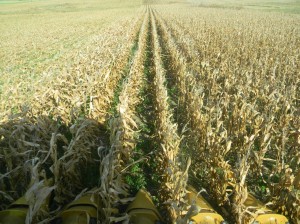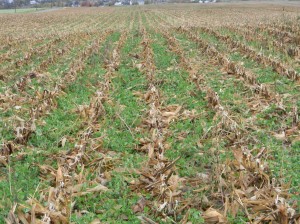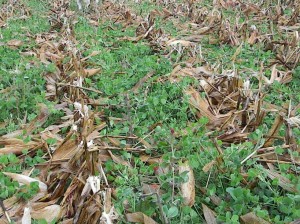One of the problems with cover crops is how to get them seeded. The idea behind cover crops is to have something growing in the fields all the time to prevent soil erosion and to prevent fertilizer from washing away. To plant the cover crops we have to drive through the corn, soybeans, or wheat to seed them, or we need to fly them on with a crop duster, or we need to plant them after we harvest the cash crop.
Driving through the cash crop damages the cash crop, you always will run over some of it. Flying on is expensive, and it’s hard to get the seed where you want it, and not where you don’t want it with a plane. Planting after harvest is hard to get done; it takes a person and equipment during the busy time of harvest, and there’s often not enough growing season left after harvest to get the cover crop growing.
This year I tried seeding clover into the standing corn when we applied nitrogen in the spring. We apply nitrogen when the corn is knee high or so, early in June most years. That gives the corn a shot of the fertilizer it needs as it starts to really grow.
I’m going across the fields anyway to put on the nitrogen, so if I spread the clover at the same time I’m saving a trip across the fields, saving labor and fuel and wear and tear on the machinery.

The blue bar with the disks and knives is the nitrogen applicator. It delivers a stream of liquid nitrogen between the corn rows and under the soil. The clover seeder is the red box mounted on the back of the nitrogen bar. All the clover seeder is is a box with a spinning fan underneath it. The clover seed trickles out of the box and the fan throws it out more or less evenly.
The clover seeder is a piece of ancient equipment we’ve had sitting around in the barn forever. By happy coincidence it throws clover the same width as our nitrogen applicator. It made a cost-free way to give this method of cover crop seeding a try.
I seeded the clover on June 6th at about 10 lbs per acre. Actually, Lana seeded most of it. I helped by wringing my hands and fretting over whether we were getting too much or too little clover on.
We received essentially no rain from early May until late July. I figured this experiment would be a failure. But surprisingly the clover seed laid there and when the rains started in late July it grew.
We had a wonderful stand of clover by harvest time.

You can see the clover between the rows and see the green cast across the harvested part of the field.


In this last picture you can see some of the crimson blossoms. This is crimson clover.
This approach certainly worked well this year. I’m anxious to try it again next year[1] and see how it works.
[1] Next year will be a normal year, with rain and sun each in the appropriate measure. I gar-on-tee it.
Leave a Reply